Beginnings of the Holodeck: AMD's DX11 GPU, Eyefinity and 6 Display Outputs
by Anand Lal Shimpi on September 10, 2009 2:30 PM EST- Posted in
- GPUs
Wanna see what 24.5 million pixels looks like?

That's six Dell 30" displays, each with an individual resolution of 2560 x 1600. The game is World of Warcraft and the man crouched in front of the setup is Carrell Killebrew, his name may sound familiar.
Driving all of this is AMD's next-generation GPU, which will be announced later this month. I didn't leave out any letters, there's a single GPU driving all of these panels. The actual resolution being rendered at is 7680 x 3200; WoW got over 80 fps with the details maxed. This is the successor to the RV770. We can't talk specs but at today's AMD press conference two details are public: 2.15 billion transistors and over 2.5 TFLOPs of performance. As expected, but nice to know regardless.
The technology being demonstrated here is called Eyefinity and it actually all started in notebooks.
Not Multi-Monitor, but Single Large Surface
DisplayPort is gaining popularity. It's a very simple interface and you can expect to see mini-DisplayPort on notebooks and desktops alike in the very near future. Apple was the first to embrace it but others will follow.
The OEMs asked AMD for six possible outputs for DisplayPort from their notebook GPUs: up to two internally for notebook panels, up to two externally for conncetors on the side of the notebook and up to two for use via a docking station. In order to fulfill these needs AMD had to build in 6 lanes of DisplayPort outputs into its GPUs, driven by a single display engine. A single display engine could drive any two outputs, similar to how graphics cards work today.
Eventually someone looked at all of the outputs and realized that without too much effort you could drive six displays off of a single card - you just needed more display engines on the chip. AMD's DX11 GPU family does just that.
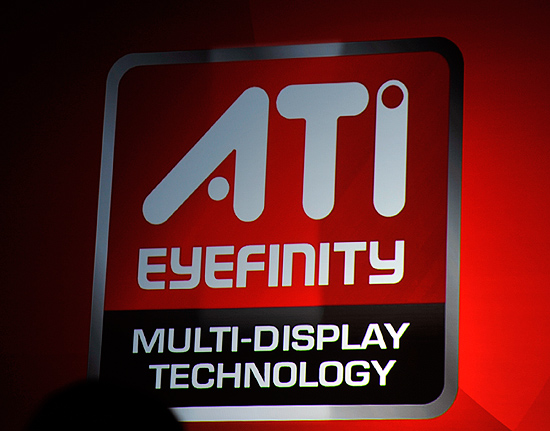
At the bare minimum, the lowest end AMD DX11 GPU can support up to 3 displays. At the high end? A single GPU will be able to drive up to 6 displays.

AMD's software makes the displays appear as one. This will work in Vista, Windows 7 as well as Linux.
The software layer makes it all seamless. The displays appear independent until you turn on SLS mode (Single Large Surface). When on, they'll appear to Windows and its applications as one large, high resolution display. There's no multimonitor mess to deal with, it just works. This is the way to do multi-monitor, both for work and games.
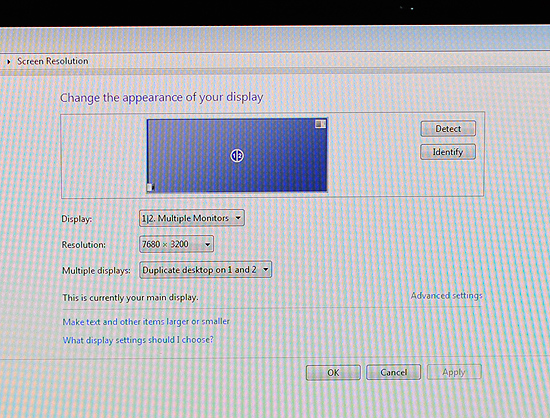
Note the desktop resolution of the 3x2 display setup
I played Dirt 2, a DX11 title at 7680 x 3200 and saw definitely playable frame rates. I played Left 4 Dead and the experience was much better. Obviously this new GPU is powerful, although I wouldn't expect it to run everything at super high frame rates at 7680 x 3200.
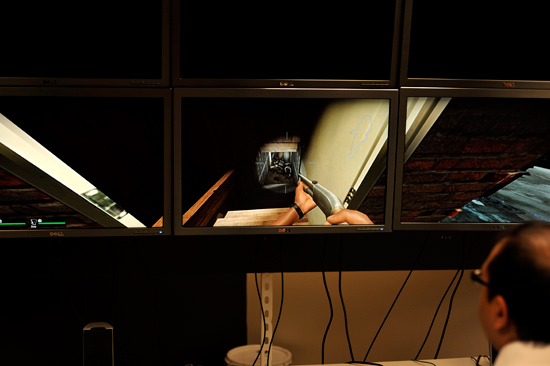
Left 4 Dead in a 3 monitor configuration, 7680 x 1600
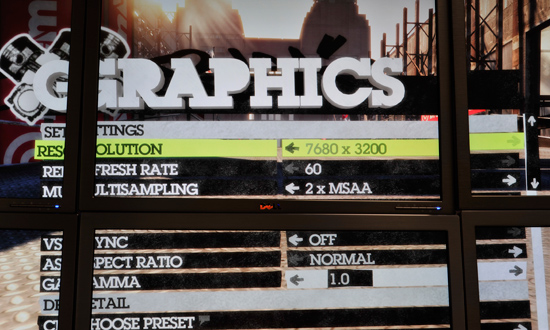
If a game pulls its resolution list from Windows, it'll work perfectly with Eyefinity.
With six 30" panels you're looking at several thousand dollars worth of displays. That was never the ultimate intention of Eyefinity, despite its overwhelming sweetness. Instead the idea was to provide gamers (and others in need of a single, high resolution display) the ability to piece together a display that offered more resolution and was more immersive than anything on the market today. The idea isn't to pick up six 30" displays but perhaps add a third 20" panel to your existing setup, or buy five $150 displays to build the ultimate gaming setup. Even using 1680 x 1050 displays in a 5x1 arrangement (ideal for first person shooters apparently, since you get a nice wrap around effect) still nets you a 8400 x 1050 display. If you want more vertical real estate, switch over to a 3x2 setup and then you're at 5040 x 2100. That's more resolution for less than most high end 30" panels.
![]()
Any configuration is supported, you can even group displays together. So you could turn a set of six displays into a group of 4 and a group of 2.
It all just seems to work, which is arguably the most impressive part of it all. AMD has partnered up with at least one display manufacturer to sell displays with thinner bezels and without distracting LEDs on the front:
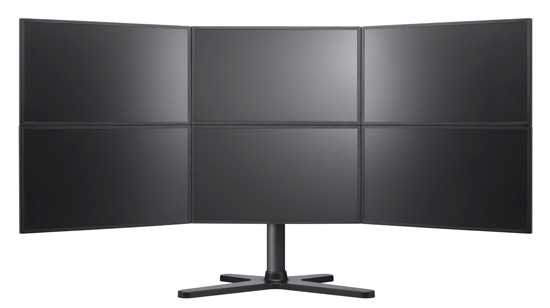
A render of what the Samsung Eyefinity optimized displays will look like
We can expect brackets and support from more monitor makers in the future. Building a wall of displays isn't exactly easy.










137 Comments
View All Comments
pixel00706 - Friday, September 11, 2009 - link
Yeah But imagine 6 X cheapy data projectors....no lines massive display :). Problem is an area big enough to project it ontoGriswold - Friday, September 11, 2009 - link
Case in point, look at the WoW screen shot..screen cut right in half were character is located. lolI wonder why they didnt use pivot to circumvent that problem. Five displays in a single row instead of two and the center display will not cut the area with the character in half, while at the same time provide the desired hight at the cost of some width. That would work for me...
duploxxx - Friday, September 11, 2009 - link
perhaps have a look at Barco, also one of the preferred ATI/AMD board vendors and see what they do with screens, they already have full glued monitors where you can drive 2 gpu to 1 monitormisuspita - Friday, September 11, 2009 - link
Those monitors are not thought out for that purpose. But http://www.seamlessdisplay.com/products_radius320....">http://www.seamlessdisplay.com/products_radius320.... these are.Iketh - Friday, September 11, 2009 - link
Please read the entire article before posting. It's clearly stated that AMD already has one manufacturer lined up to make monitors with very thin bezels, and for FPSs, you would use an odd number of displays so your crosshairs are in the center of a monitor. It's all in the article.RamarC - Thursday, September 10, 2009 - link
gotta agree. nice tech demo, but wouldn't you rather have a single 60+ inch LED display?zebrax2 - Thursday, September 10, 2009 - link
How many organs do i have to sell to buy a 60+ inch led display with a resolution greater than 25+ mega pixels? Seriously though yields would be so low on those.taltamir - Thursday, September 10, 2009 - link
Building such a monitor is not difficult. Making something run on it is.
By giving us the software, the open the door for a company to design such a monitor.
erple2 - Thursday, September 10, 2009 - link
[quoting block]I've yet to see someone use a monitor setup like that for gaming. It looks terrible with the lines between monitors. Video card manufacturers have been trying that for ages now, Matrox tried and failed at it already. Let it die. AMD.[/quoting block]I think that what makes this a brilliant thing isn't that you _can_ hook up 6 monitors to a single graphics card, but that it works as if it's just one monitor. I think THAT is the innovation that ATI's done - all other implementations I've seen basically treat each monitor as a separate entity, and have to handle them within the OS separately. This treats it all as a single 7500x3200 resolution display. THAT is the cool part, I think.
I think that one of the things that Matrox did back in the day was some clever tricks to try and get the OS to recognize the displays correctly. Looking back on it, there was this concept of "primary display", "secondary display" and "tertiary display". Not "this is my display that's huge".
Perhaps it's just a "name swap", but I can see that this sort of thing is what you need for abstracting arbitrarily large displays (made of one, giant, single display or multiple smaller displays).
sparkuss - Thursday, September 10, 2009 - link
I could see it working if they just find a different mounting scheme.It seems the only obstacle is the bezels, surely there's technology for that side of the coin as well to allow the panels to butt up against each other without a bezel.
I have already seen flight sim stations that it won't be a problem for even now because the "cockpit" windows already encompass a bezel.
Course once we have flexible "affordable" OLEDs maybe even wilder setups possible.